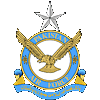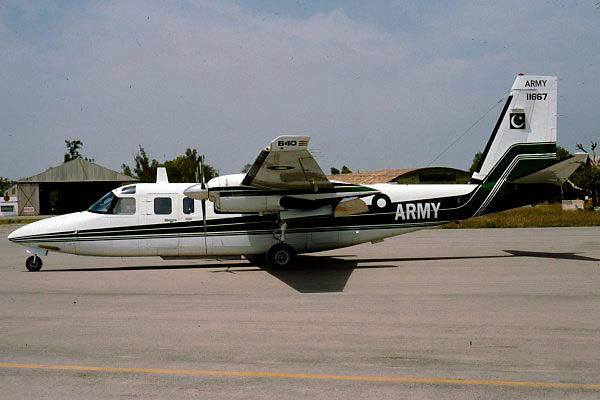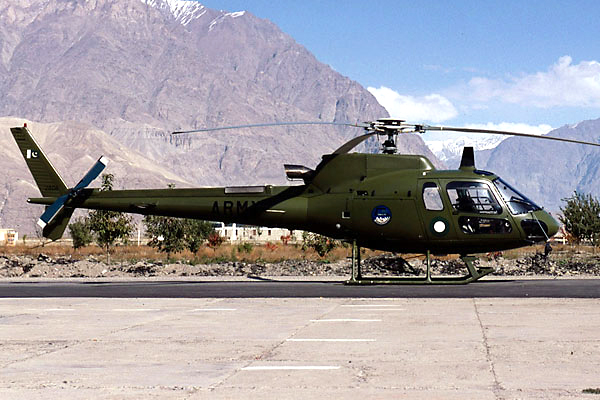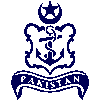Brief history
When the Pakistan Air Force (PAF) was established on August 15, 1947, it had only a small amount of aircraft and only few to fly that amount. There were even fewer places to fly from. The PAF came into being with only thirty-two C-47 Dakotas and types like Tempests, Harvards, Tiger Moths and Auster V's which were delivered to No. 5, 6 and 9 Squadron. Operating these types of aircraft in Pakistan was far from ideal. The Dakotas were having severe trouble flying at their maximum altitude of 10.000 feet to avoid the tops of the world's highest mountains. Because most mountains in northern Pakistan are even taller than that, only one route, which lead through the narrow Indus Valley, could be used to reach the important supply-airfields Chilas, Bunji, Gilgit and Skardu.
The Jet age
Despite the lack of funds and market-places, Pakistan Air Force entered the jet age in August 1951 with the arrival of three first-generation jet fighters - British built Attackers. They formed the nucleus of the new Number 11 Squadron. Pakistan began to court the Americans, who agreed in principle to supply F-94Cs, F-86 Sabres and F-84s, the USAF's standard fighter-bomber. Finally, PAF opted for the F-86F Sabres. The PAF received 102 F-86F Sabres during the first stage followed by 90 ex West-German CL13B Mk.6s, which were referred to locally as F-86E. These Sabres were sold to Iran originally but were immediately resold to Pakistan. During a ten year-period, from 1955 until 1965, a build-up of more modern material began with the deliveries of F-104 Starfighters and B-57 bombers. Next to that some C-130s were added to the transport fleet and for training purposes Harvards and T-33s were purchased. To perform the reconnaissance task the RT-33 joined the force. When the first Starfighters arrived in 1961, Pakistan was the first country in Asia to operate a Mach 2-fighter which was not only fast but also equipped with the most modern equipment.

Photo: Erwin van Dijkman
The war of '65
On the 6th of September 1965 war broke out between India and Pakistan. During the beginning of this offensive a PAF F-104 shot down an Indian Air Force Mystère IV with one of its sidewinders making the first combat kill with a Mach 2-capable aircraft. Pakistan made counter attacks on Indian soil using F-104s, F-86s, B-57s and RT-33As. The war lasted for 23 days and in Pakistan it is considered a glorious victory for that country. The Six-Day War between Israel and a number of Arab countries in 1967. During this conflict the PAF sent personnel to Egypt, Jordan and Syria to support the Arabs in their battle against the Israelis. PAF pilots managed to shoot down ten Israeli aircraft, including Mirages, Mystères and Vautours, without losses on their own side. The PAF pilots operated with Egyptian, Jordanian and Iraqi combat aircraft.
The war of '71
This conflict mainly played in Pakistan's eastern sector. According to Pakistani sources the PAF managed to destroy 51 IAF aircraft plus 17 unconfirmed against own losses of forty planes.
Yom Kippur War, October 1973
During this war 16 PAF pilots volunteered to leave for the Middle East in order to support Egypt and Syria but by the time they arrived Egypt had already agreed on a cease-fire. Syria remained in a state of war against Israel so the PAF pilots became instructors there and formed the A-flight of 67 Squadron at Dumayr AB. Later on PAF pilot Flt. Lt. Sattar Alvi was honoured by the Syrian government.
The 80s
In December 1981, the government of Pakistan signed a letter of agreement for the purchase of 40 F-16A/B fighters for the Pakistan Air Force. The first aircraft were accepted at Fort Worth in October of 1982. Transition training for Pakistani aircrews and ground personnel was carried out by the 421st Tactical Fighter Squadron of the 388th Tactical Fighter Wing at Hill AFB in Utah. The first two F-16As and four F-16Bs arrived in Pakistan in January 1983. The Pakistani F-16A/Bs were all Block 15 machines, the final version of the F-16A/B production run. Their power plant is the Pratt & Whitney F100-P W-200 turbofan. The first unit to be equipped with the F-16 was No. 11 Squadron located at PAF Base Sargodha. All forty of the Fighting Falcons had entered PAF service by mid-1986. This made it possible to establish two more squadrons, No.9 at Sargodha and No. 14 at Kamra. No 11 Squadron operated as the OCU.
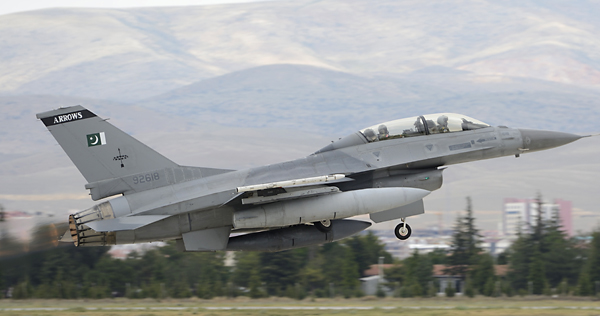
Photo: Erwin van Dijkman
The Afghan War, 1980-1988
The Soviet invasion of Afghanistan in 1979 in support of the pro-Soviet government in Kabul which was being hard-pressed by Mujahadeen rebel forces marked the start of a decade-long occupation. Mujahadeen rebels continued to harass the occupying Soviet military force as well as the forces of the Afghan regime that it was supporting. The war soon spilled over into neighbouring Pakistan, with a horde of refugees fleeing to camps across the border in an attempt to escape the conflict. In addition, many of the rebels used Pakistan as a sanctuary from which to carry out forays into Afghanistan, and a steady flow of US-supplied arms were carried into Afghanistan from staging areas in Pakistan near the border. This inevitably resulted in border violations by Soviet and Afghan aircraft attempting to interdict these operations. Between May 1986 and November 1988, PAF F-16s have shot down at least eight intruders from Afghanistan. The first three of these (one Su-22, another one probably an Su-22 and one An-26) were shot down by two pilots from No. 9 Squadron. Pilots of No. 14 Squadron destroyed the remaining five intruders (two Su-22s, two MiG-23s, and one Su-25). In most of these kills the AIM-9 Sidewinder was used, but at least one plane (an Su-22) was destroyed by cannon fire. Flight Lieutenant Khalid Mamood is credited with three of these kills. At least one F-16 was lost in these battles, in an encounter between F-16s and six Afghan Air Force aircraft on 29 April 1987. However, the lost F-16 appears to have been an "own goal", having been hit by a Sidewinder fired by the other F-16. The unfortunate F-16 pilot ejected safely. Pakistani F-16s typically carry two all-aspect AIM-9Ls on the wing tip rails along with a pair of AIM-9Ps on the outermost under wing racks. Pakistani F-16s have an important strike role, being fitted with the French-built Thomson-CSF ATLIS laser designation pod and the capability to deliver Paveway laser-guided bombs. The ATLIS was first fitted to Pakistani F-16s in January 1986. The F-16 became the first non-European aircraft to be qualified for the ATLIS pod.
The 90s
The 90s saw the delivery of further squadrons of F-7Ps. A large number of for RAAF (Royal Australian Air Force) Mirage 3s found their way to Pakistan and were taken on charge after an upgrade. After the Mirage 3/5 was phased out with the French air force the PAF by far became the main user of Mirage 3/5 aircraft. The PAF also took over large number of Mirage 3/5 aircraft from France in the mid-nineties. The 90s have furthermore been influenced by the US embargo. Having ordered a total of 71 additional F-16s the US, in accordance to the Pressler amendment to the Foreign Assistance Act, announced an embargo on all arms deliveries to Pakistan on 6 October 1990. As a result of this, further deliveries never took place (the ones already built were stored at AMARC). Notwithstanding the US sanctions the PAF has been keeping the US aircraft types airworthy and maintained, like the F-16s, T-37s, C-130s and B-707. The F-16A/Bs were allocated to 2 squadrons being the No. 9 Sq. and the No. 11 (OCU) Sq. located at PAF Base Sarghoda (later renamed PAF Mushaf).
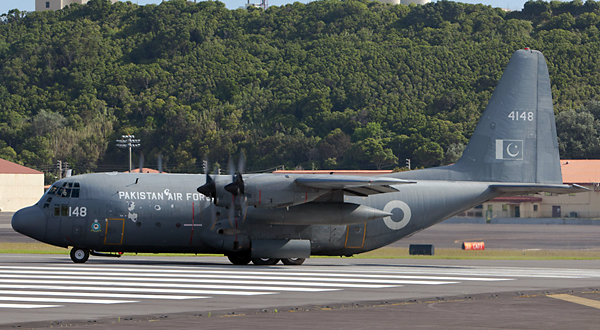
Photo: Reinold Kalsbeek
The PAF Today
Things changed drastically in the new millennium. Not only was the Grifo 7 radar chosen for introduction in the F-7P (the radar being built by the Pakistan Aeronautical Complex at Kamra), the PAF also received over 60 F(T)-7PG aircraft to replace the ageing F-6 Farmers. Additional Mirages were yet again acquired from Lebanon and Libya. For their help in the anti-terrorism activities the US promised military aid to Pakistan in 2002 and declared Pakistan a Major Non-NATO ally in 2004. This eventually led to the US granting permission to order and deliver F-16s to the country again. The order for eighteen new built F-16C/D Block 50/52 was signed September 2006. It also included delivery of the F-16s that were affected by the embargo in the 90s! . Furthermore six (former RAAF) C-130 were delivered to bolster the transport capacity.
Another new type is the FC-1/JF-17 Thunder. The aircraft was developed by a joint venture between CAC and Pakistani Aeronautical Complex (PAC). PAF hopes to acquire 150 aircraft of this type to replace a large number of the A-5s, Mirages and older F-7s. The first two aircraft for Pakistan arrived on 2 March 2007. They were officially presented on 12 March 2007 and made their first public appearance during the Pakistan Day Parade on 23 March 2007. The type is currently being assembled by PAC. The aerobatic team the Sherdils (Urdu for "lionhearted") currently flies the K-8 Karakorum. The K-8 has been ordered in multiple batches and they are being delivered to the Primary Flying Training Wing (PAF Academy) at Risalpur, replacing the T-37 Tweet. The training unit also operates a large number of Mushshak and Super Mushshaks (the main improvement on this modified version is a more powerful engine).
In 2006 the country placed an order for Swedish Saab 2000 aircraft equipped with the Erieye-system. The first one was delivered in 2010. This type will give the PAF the AWACS-capacity it was looking for. For the same reason Pakistan has also ordered four modified Shaanxi Y8 aircraft (renamed ZDK-03) from China. Air-to-air refuelling capacity was added in 2009 with the arrival of the first of four Il-78 tankers. The PAF saw the arrival of Mi-17 transport helicopters and appears to operate a number of Bell 412s as well (26 helicopters of this type were delivered to the various services in 2004/2005). A total of 18 F-16C/D Block 52 aircraft were delivered to a new air base at Shahbaz in 2010. A repeat order for 18 more is still being considered.
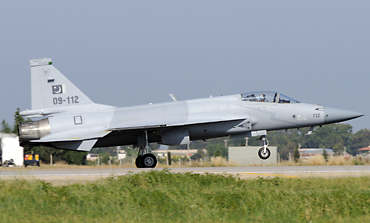
Photo: Erwin van Dijkman






